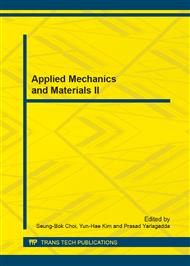[1]
S. Russell and P. Norvig. Artificial Intelligence, A Modern Approach. Prentice Hall, (1995).
Google Scholar
[2]
J. Kennedy and R. Eberhart. Swarm Intelligence. Morgan Kaufmann Publishers, (2001).
Google Scholar
[3]
Eberhart, R. C. and Kennedy, J., A New Optimizer Using Particle Swarm Theory, Proc. Of the 6th Int. Symp. on Micro Machine and Human, Science, Nagoya, Japan, 1995, pp.39-43.
DOI: 10.1109/mhs.1995.494215
Google Scholar
[4]
Kennedy, J. and Eberhart, R.C., Particle Swarm Optimization, Proc. of IEEE International Conference on Neural Network, Perth, Australia, 1995, p.1942-(1948).
Google Scholar
[5]
Yoshida, H., Kawata, K., Fukuyama, Y. and Nakanishi, Y., A Particle Swarm Optimization for Reactive Power and Voltage Control Considering Voltage Stability, Proc. of International Conference on Intelligent System Application to Power Systems, Rio de Janeiro, Brazil, 1999, pp.117-121.
DOI: 10.1109/pesw.2001.916897
Google Scholar
[6]
Abido, M. A., Particle Swarm Optimization for Multimachine Power System Stabilizer Design, Proc. of Power Engineering Society Summer Meeting, 2001, pp.1346-1351.
DOI: 10.1109/pess.2001.970272
Google Scholar
[7]
Messerschmidt, L. and Engelbrecht, A. P., Learning to Play Games Using a PSO-Based Competitive Learning Approach, IEEE Trans. Evolutionary Computation, Vol. 8, No. 3, 2004, pp.280-288.
DOI: 10.1109/tevc.2004.826070
Google Scholar
[8]
Li, Y. and Chen, X., Mobile Robot Navigation Using Particle Swarm Optimization and Adaptive NN, Proc. of the First International Conference on Natural Computation (ICNC), Lecture Notes in Computer Science, Springer, Vol. 3612, 2005, pp.554-559.
DOI: 10.1007/11539902_76
Google Scholar
[9]
H. El-Mounayri, Z. Dugla, H. Deng, Prediction of Surface Roughness in End Milling using Swarm Intelligence, Proceedings of the 2003 IEEE Swarm Intelligence Symposium, 2003, pp.220-227.
DOI: 10.1109/sis.2003.1202272
Google Scholar
[10]
C. Scheffer, H. Kratz, P. S Heyns, F. Klocke, Development of a tool wear-monitoring system for hard turning, International Journal of Machine Tools and Manufacture, Vol. 43, 2003, pp.973-985.
DOI: 10.1016/s0890-6955(03)00110-x
Google Scholar
[11]
Y. Shi, R. C. Eberhart, Parameter Selection in Particle Swarm Optimization, Proceedings of 7th Annual Conference on Evolutionary Programming, San Diego, (1998).
Google Scholar


